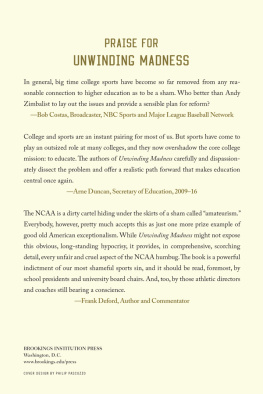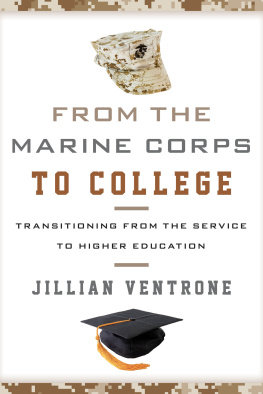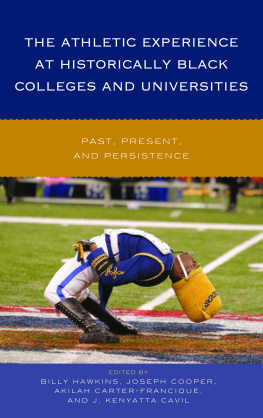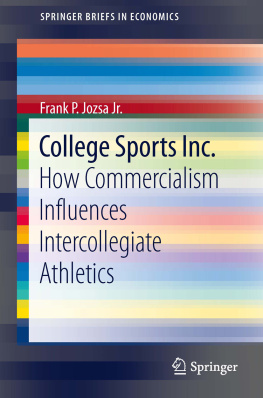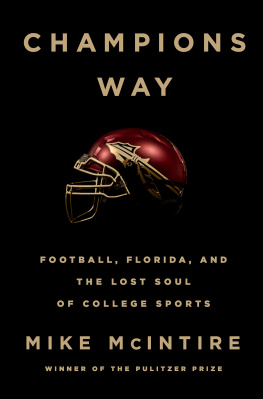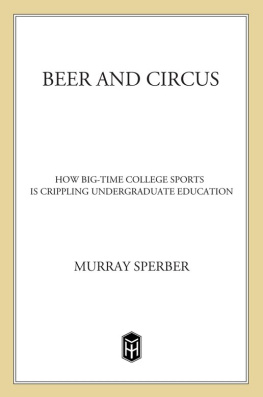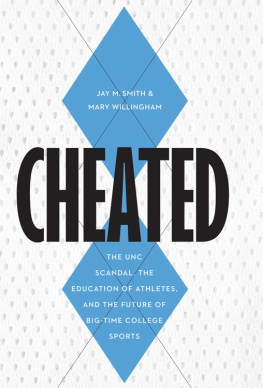UNWINDING MADNESS
What Went Wrong with College Sportsand How to Fix It
GERALD GURNEY
DONNA LOPIANO
ANDREW ZIMBALIST
BROOKINGS INSTITUTION PRESS
Washington, D.C.
Copyright 2017
THE BROOKINGS INSTITUTION
1775 Massachusetts Avenue, N.W., Washington, D.C. 20036
www.brookings.edu
All rights reserved. No part of this publication may be reproduced or transmitted in any form or by any means without permission in writing from the Brookings Institution Press.
The Brookings Institution is a private nonprofit organization devoted to research, education, and publication on important issues of domestic and foreign policy. Its principal purpose is to bring the highest quality independent research and analysis to bear on current and emerging policy problems. Interpretations or conclusions in Brookings publications should be understood to be solely those of the authors.
Library of Congress Cataloging-in-Publication data are available.
ISBN 978-0-8157-3002-6 (cloth : alk. paper)
ISBN 978-0-8157-3003-3 (ebook)
9 8 7 6 5 4 3 2 1
Printed on acid-free paper
Typeset in Minion Pro
Composition by Westchester Publishing Services
Contents
Preface
College sports are in educational, ethical, and economic turmoil. During the last ten years, litigation after litigation have sprung up alleging that the NCAA violates antitrust laws, runs afoul of the Fair Labor Standards Act, and imposes arbitrary, morphing and unfair definitions of amateurism. The football players at Northwestern University attempted to unionize, and the National Labor Relations Board (NLRB) wrote in its 2015 decision not to certify the effort that it would not promote stability in labor relations to assert jurisdiction in this case and that there have been calls for the NCAA to undertake further reforms that may result in additional changes to the circumstances of scholarship players. In other words, it concluded that college sports are changing too rapidly for it to be prudent to enter the fray. The NLRB noted a need for the U.S. Congress to take a close look at college sports and provide guidance.
The authors of this book have been involved in the movement to reform college sports for more than four decades. During the past two years, we have been part of a working group connected to the Drake Group to study college sports and formulate a vision of a new governing system for intercollegiate athletics.
The authors have also lent their support to H.R. 2731, which calls for the establishment of a presidential commission to study college sports and to consider public policy options for promoting its reform. Along the way, we have met with members of Congress, the White House senior staff for domestic policy, former secretary of education Arne Duncan, academic colleagues, college administrators, and executives of the American Association of University Presses, the Knight Commission on Intercollegiate Sports, and the American Council on Education, among others.
While we note that the NCAAs new public relations mantra insists that its priorities are academics, student-athlete well-being, and fairness, we believe this statement is disingenuous. From the perspectives of college athletes, academics, sport fans, or even the most casual observers, this assertion seems merely to repeat broken promises.
The forces of commercialism are transforming college sports. The pace and substance of this change will likely deepen over the coming five years. The opportunity to influence the reform debate and the future trajectory of college sports is too alluring to pass up. Thats why we wrote this book.
Our narrative proceeds in three parts. concludes with a more targeted discussion of reform strategies, principles, and policies.
Throughout, we adhere to a consistent theme. We believe that intercollegiate athletics is at a tipping point. The status quo is not stable, and change is coming. This change can move college sports further toward commercialization and professionalism or it can endeavor to reinforce the historical vision of college sports as an amateur activity subordinated to and in harmony with the educational mission of U.S. colleges. The former path will lead to increasing academic scandals, widespread financial insolvency, and diminishing support for Olympic sports and Title IX. The latter path, while not without its own challenges, may succeed in restoring a proper balance between athletics and academics. We lay out a multifaceted proposal that links favorable fiscal and legal treatment for college athletics to the NCAA or another governing body providing robust and comprehensive educational reforms.
Our critique of college sports pertains mostly to Division I, its Football Bowl Subdivision, and the Power Five conferences. It is inevitable that within each of these groups there is behavioral variance among schools, college administrators, athletics directors, and coaches. While we note some of this variability, we focus on the central dynamics and common elements moving the system.
Numerous colleagues have helped us formulate the positions we articulate in the book. In particular, we would like to single out Ted Fay, Roger Noll, Amy Perko, Brian Porto, Dave Ridpath, Steve Ross, Allen Sack, and Mary Willingham. We are also indebted to Jayma Meyer for extensive comments on an early draft of the manuscript. Of course, any errors that remain are entirely our responsibility.
PART I
Lessons of History
How College Sports Lost Its Way I
The phrase American exceptionalism is frequently used to mean that the United States does things differentlyand, by connotation, betterthan the rest of the world. There is little question but that intercollegiate athletics in the United States is different from athletics in other countries. In England and elsewhere, college athletics is largely organized on an intramural or student club basis, offering students a recreational respite from the intellectual rigors of the classroom. Highly competitive elite-level sport resides in private clubs outside the institution. In the United States, from its earliest days, elite-level sport has been embedded within the educational institution. This structural distinction, the integration of elite sport with academia and the concomitant annual striving to win in head-to-head competition against other institutions, lies at the root of current challenges. However, this structural differentiation does not fully explain why National Collegiate Athletic Association (NCAA) Division I athletic programs have lost their way. To understand the growth of the most corrosive aspects of increased commercialism, the rejection of athletic program resource controls, the demands for plutocracy, the NCAAs selective enforcement of rules, and the turning of a blind eye to academic fraud, it is necessary to trace the history of how college sport has failed at critical decisionmaking junctures.
American Higher Education Embraces Commercialized Sport
Despite the pretenses of U.S. collegiate sports to be educationally oriented, strictly amateur activities, the commercial aspects of college sports programs have progressively encroached on the educational terrain and, at the upper reaches of Division I, have subverted it. It is important to understand how college presidents developed the convictions that successful sports teams afford prime promotion opportunities for the school and that winning elite-level sports contests results in significant marketplace advantages for the institution.
The first college sports contest, the rowing match between the Harvard and Yale boat clubs on Lake Winnipesaukee in 1852, was infused with commercial motives. The manager of the Boston, Concord and Montreal Railroad organized the event to advertise the lines rail service to wealthy clientele in New York and Boston. The railroad company lured the boat teams to the match with unlimited alcohol and lavish prizes. The first known college sports eligibility abuse came three years later at another Harvard-Yale meet, when the Harvard teams coxswain was not a student.
Next page
